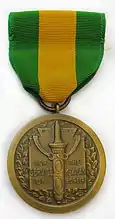| Mexican Border Service Medal | |
|---|---|
 | |
| Type | Service medal |
| Awarded for | National Guard troops federalized for service against Mexico, but who did not qualify for the Mexican Service Medal. |
| Country | |
| Presented by | Secretary of War |
| Status | Obsolete |
| Established | July 9, 1918 |
| Total recipients | 41,000 |
| Precedence | |
| Next (higher) | Mexican Service Medal |
| Next (lower) | World War I Victory Medal |
| Related | Texas Cavalry Medal |
The Mexican Border Service Medal was a U.S. service medal established by an Act of Congress on July 9, 1918.[1] It was awarded for service on the border between May 9, 1916 and March 24, 1917.[1] Additionally, recipients included those who performed duty with the Mexican Border Patrol between January 1, 1916 and April 6, 1917.[1]
History
The Mexican Border Service Medal recognized military service members who were assigned to the U.S.-Mexico border when the United States was engaged in the Pancho Villa Expedition, a military operation conducted against the paramilitary forces of Francisco "Pancho" Villa during the Mexican Revolution.[2] The U.S.-Mexico border was a potential location for a German-funded invasion by Mexico, which was exposed by British interception of the Zimmerman Telegram, a communication that detailed Germany's proposal for Mexico to ally with Germany if the United States entered World War I.[3]
Those who received the Mexican Service Medal were not eligible for the Mexican Border Service Medal.[1] The first recipient was Major General Charles M. Clement of Pennsylvania, in recognition of his status as the longest-tenured National Guard officer eligible for the award at the time it was authorized.[4] Congress created a similar award for members of the Texas National Guard who served on the border between December 8, 1917 to November 11, 1918, the Texas Cavalry Medal.[5]
Description
As approved by the U.S. Congress:[6]
The medal of bronze is 1 1/4 inches in diameter. On the obverse is a sheathed Roman sword hanging on a tablet on which is inscribed For service on the Mexican border. The tablet is surrounded by a wreath. The reverse is the same as that of the Spanish War Service Medal. The medal is suspended by a ring from a silk moire ribbon 1 3/8 inches in length and 1 3/8 inches in width composed of a green band (7/16 inch), yellow band (1/2 inch), and green band (7/16 inch).
See also
References
- 1 2 3 4 U.S. Army Adjutant General (1950). The Army Almanac: A Book of Facts Concerning the Army of the United States. Washington, DC: U.S. Government Printing Office. p. 680 – via Google Books.
- ↑ Yockelson, Mitchell (Winter 1997). "The United States Armed Forces and the Mexican Punitive Expedition: Part 2". Prologue Magazine. Washington, DC: U.S. National Archives and Records Administration. Retrieved January 4, 2024.
- ↑ "Zimmermann Telegram: Germany's secret proposal to Mexico, discovered". The World War.org. Kansas City, MO: National WWI Museum and Memorial. Retrieved January 4, 2024.
- ↑ "General Clement Gets Two Medals". Harrisburg Telegraph. Harrisburg, PA. June 24, 1919. p. 2 – via Newspapers.com.
- ↑ Annual Report of the Chief of the Militia Bureau. Washington D.C.: Government Printing Office. 1926. pp. 54–55. Retrieved September 9, 2015 – via Google Books.
- ↑ "Title 32 CFR 578.39: Mexican Border Service Medal". Code of Federal Regulations (Annual Edition). Washington, DC: U.S. Government Printing Office. July 1, 2002. Retrieved January 4, 2024.
External links
 Media related to Mexican Border Service Medal at Wikimedia Commons
Media related to Mexican Border Service Medal at Wikimedia Commons